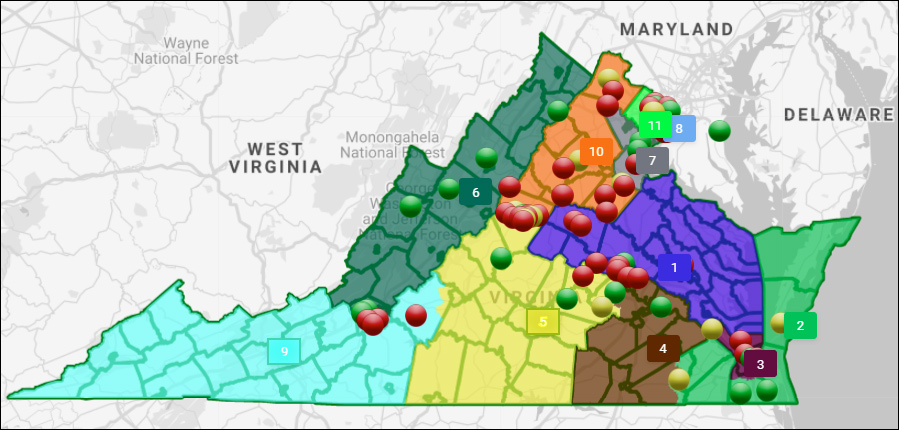By Jim Ellis
Dec. 13, 2021 — The Virginia congressional redistricting map was just published and it contains some surprises. Unexpectedly, the overall plan features more competitive districts than the current map, and the state’s three female members each drew more difficult political situations. All eight males would have safe seats.
Because the Virginia Redistricting Commission members failed to produce a new congressional map by the stated deadline, the Supreme Court of Virginia was forced to assume map drawing responsibilities. The court hired two special masters, a Democrat and a Republican, to collaborate and produce a new federal map.
The 11-district plan enhances the political competition in two seats when compared to vote totals typically yielded from the current map and creates a new open seat that sets the scene for a highly contested Democratic primary. The districts of Reps. Elaine Luria (D-Norfolk) and Jennifer Wexton (D-Leesburg) clearly become more competitive, while Rep. Abigail Spanberger (D-Glen Allen) has no reasonable place to run.
Instead of placing the new 7th District in the central part of the state beginning in Henrico County where Rep. Spanberger resides, the seat is transferred to Northern Virginia and will occupy all of Prince William and Stafford counties along with the cities of Manassas, Manassas Park, and Fredericksburg in addition to a small piece of southeastern Fairfax County. The FiveThirtyEight statistical organization rates the new 7th as D+14.
Immediately, two Democratic candidates who this year ran statewide — gubernatorial candidate Jennifer Carroll Foy and Hala Ayala, the lieutenant governor nominee — both expressed interest in running for the new seat. Both women are former state delegates. Though the new Prince William-anchored district is numbered seven, none of Spanberger’s current constituents reside here.
First District Rep. Rob Wittman (R-Montross) loses the Northern Virginia region he currently represents and sees his district move west. It picks up the western part of Henrico County and pairs him with Rep. Spanberger. With the statistics projecting the new 1st as R+16, it appears any Wittman-Spanberger campaign would end badly for the Democratic congresswoman.
The remaining parts of the Spanberger constituency have gone to Rep. Donald McEachin’s (D-Richmond) 4th District, and Rep. Wexton’s 10th CD. Such would force Rep. Spanberger to challenge a sitting Democratic incumbent if she were to choose to run in one of these seats. In no situation does Rep. Spanberger have a reasonable victory path.
Rep. Luria’s 2nd District gets more Republican. The FiveThirtyEight political data website statisticians see this seat moving from a 51-47 percent Biden district to an R+6 domain. This happens because the Norfolk and Hampton portions of the 2nd, including Rep. Luria’s residence, are moved to District 3. Williamsburg and the surrounding area and part of the city of Chesapeake, the counties of Suffolk, Isle of Wight, and Southampton, along with the city of Franklin are then added to the Luria seat. We can expect a strong Republican candidate to emerge here, one who could possibly unseat the Democratic incumbent.
Northern Virginia’s 10th District originally leaned Republican, but the seat that contained parts of Fairfax and Prince William counties, along with Loudoun and Clarke counties, has mirrored the state in terms of moving beyond marginal political status to becoming reliably Democratic. Rep. Wexton’s new 10th returns to marginal status, as FiveThirtyEight ranks the previous 59-40 percent Biden district to just D+2 based upon aggregate political results.
Additionally, more than half of the new 10th is unfamiliar territory for Rep. Wexton, as a major part of her district has been placed in District 7. Regardless of which party wins this seat in 2022, it will be viewed as a future conversion opportunity for the party that loses the race.
Another Wexton option might be to run in the new 7th. A large chunk of her constituency was placed in that district, and though she would face a difficult primary election, winning it would make her safe with a non-competitive seat likely for the rest of the decade.
It’s not out of the question that Rep. Spanberger could also run here. Though she would have no constituent carryover, she is a known political entity in the Washington, DC media market and would begin the race with over $2.4 million in her campaign account to introduce herself to the new constituency.
Reps. Bobby Scott (D-Newport News), McEachin, Bob Good (R-Evington/Lynchburg), Ben Cline (R-Rockbridge/Shenandoah Valley), Don Beyer (D-Alexandria), Morgan Griffith (R-Salem), and Gerry Connally (D-Fairfax) all get safe seats under the map with a minimum number of split municipalities.
The state Supreme Court justices have final approval authority over the map their own masters drew. Since the plan’s legal criteria in terms of compactness, protection of minority voters, and keeping communities of interest whole looks to be very well met, the chances are high the court will affirm the draw.
Before that happens, however, it appears the population in each district will have to be adjusted to a deviation of +/- one person. The draft map’s districts look to have a much larger population deviation degree than allowable under federal redistricting mandates. If this map is ultimately enacted, we will see more Virginia congressional competition in 2022 than originally foreseen.

